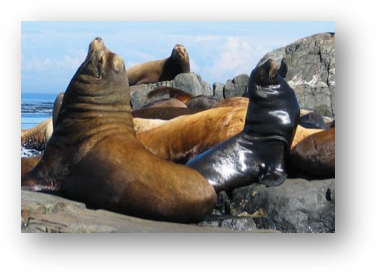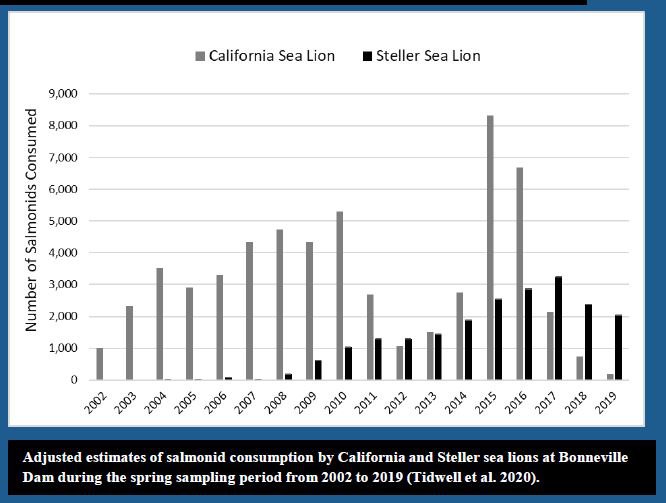Decision Expected This Summer On Application To Remove More Sea Lions
- April 17, 2020
- John Harrison

In June 2019, Northwest states and Columbia River tribes applied to the federal government for a permit to kill more sea lions in more places where they prey on adult salmon and steelhead. It now appears the National Marine Fisheries Service (NMFS) will make a decision on the application in August after receiving a recommendation from a 22-member task force formed to review the application and public comments on it.
Two species of sea lions, Californias and Stellers, prey on adult salmon, steelhead, and other fish species in the Columbia and some tributaries, primarily in the spring. This predation takes a large toll on the fish, particularly the annual return of spring Chinook salmon, as they return from the ocean, research has shown.
Because sea lions are subject to the federal Marine Mammal Protection Act, they can be harassed away from their prey, but not killed without special permission from NMFS. Harassment has been ineffective, and since 2008, when NMFS first authorized the lethal removal of a set number of the most aggressive California sea lions – not Stellers -- a total of 238 have been removed, and 210 were killed. Others were sent to zoos and aquariums. The limited authority to lethally remove California sea lions focused only on the area immediately downstream of Bonneville Dam, but even so the removals “have been pretty effective,” said Robert Anderson, NMFS West Coast Region Program Manager for Pinniped-Fishery Interactions, in a presentation to the Council at its April meeting. The state agencies and tribes also provided an update of their activities regarding sea lions in a letter to the Council.
Based on data reported by the U.S. Army Corps of Engineers, Anderson said, predation on salmon and steelhead at Bonneville Dam peaked in 2015 at 10,859 fish. But the fish kill begins near Astoria, Oregon, in the Columbia River estuary. NMFS has documented spring Chinook losses between the estuary and Bonneville Dam over several years. The highest estimated loss of spring Chinook from the estuary to the dam was nearly 225,000 fish in 2015. Since then the fish kill attributable to sea lions has been declining. In 2019, the total at the dam was 2,201. Over that time, Steller sea lions have been gradually taking a larger number of fish at Bonneville, and since 2017 have taken more fish annually than California sea lions, a reversal of predation in 2016 and previous years back to 2007, when monitoring began. The new permit requested by the states and tribes would also allow lethal removal of the most aggressive Steller sea lions.

Predation not only occurs at Bonneville, but also elsewhere -- in the Willamette River, in the Columbia downstream and upstream of Bonneville, and in some tributaries. Wild winter steelhead in the Willamette River, a threatened species, were hit particularly hard by California sea lions at Willamette Falls. The Oregon Department of Fish and Wildlife applied to NMFS in 2017 for authorization to remove California sea lions from Willamette Falls. Following a year-long public review and comment process, removal was authorized in November 2018, and the impact on steelhead was immediate.
Beginning in mid-December 2018, ODFW removed and killed 13 California sea lions, many of which were long-term residents of the area around the base of the falls. In April 2019, ODFW reported the run was approaching near-record numbers, around 3,200 fish, nearly double the 2018 return and nearly a fourfold increase from the record low return of just 822 fish in 2017. ODFW attributed this success to the removal of sea lions.
Meanwhile in 2018, following several years of lobbying by the Council, Northwest states, and Columbia River tribes, Congress passed the Endangered Salmon Predation Prevention Act of 2018, which revised a section of the Marine Mammal Protection Act.
Anderson told the Council that the legislation made “a few specific changes to lessen some of the restrictive criteria for removing animals” and changed the scope of the law to focus on a larger area than just the tailrace of Bonneville Dam. The revision also “opened the scope of applicants to include specific tribes,” he said.
Specifically, the revision expanded the range of lethal removal of sea lions, and sea lion species, beyond Bonneville Dam and added tribes as authorized applicants for permits to remove the most aggressive sea lion predators. Specifically, the revised law authorizes “the intentional lethal taking of sea lions, for the purpose of protecting species of salmon, steelhead, or eulachon that are listed as endangered species or threatened species under the Endangered Species Act, and for species of lamprey or sturgeon that are not so listed as endangered or threatened but are listed as a species of concern.” The authorization affects sea lions in the mainstem of the Columbia River from river mile 112, which is the location of the Interstate 205 Bridge between Vancouver and Portland, to river mile 292, at McNary Dam. Within this stretch of river, the authorization also includes predation by sea lions “in any tributary … that includes spawning habitat of threatened or endangered salmon or steelhead [and] is deemed to be having a significant negative impact…”
In June 2019, Oregon, Washington, Idaho, and the Nez Perce, Umatilla, Warm Springs and Yakama tribes, and a group representing Willamette River interests, petitioned NMFS under the revised Section 120(f) for authorization to lethally remove California sea lions and also Steller sea lions in the river reach identified in the law.
NOAA published a Federal Register notice about the application, solicited public comments for 60 days, received more than 22,000 comments, and then formed a 22-member task force of user and non-user groups – state and federal agencies, tribes, conservation groups, zoos, scientists, fishing groups – to review the application and comments and make a recommendation to NMFS. The task force will meet for three days, May 12-14, by video conference in light of the coronavirus social distancing requirements. The task force facilitator then will submit a report that includes the task force’s recommendation to NMFS on July 14, and NMFS will make decision on the permit application by August 14, Anderson said.
In response to a question from Idaho Council Member Jeff Allen, Anderson acknowledged that by August, more than a year will have passed since the states and tribes submitted their application, but that’s “pretty consistent with past decisions.” He said it took a lot of effort to review the application, conduct a public comment period, and form the task force with a fair representation of interests.



